In this article we describe the transmission dynamics of hantavirus in rodents using a spatio-temporal susceptible-exposed-infective-recovered (SEIR) compartmental model that distinguishes between male and female subpopulations [L.J.S. Allen, R.K. McCormack and C.B. Jonsson, Bull. Math. Biol. 68 (2006), 511-524]. Both subpopulations are assumed to differ in their movement with respect to local variations in the densities of their own and the opposite gender group. Three alternative models for the movement of the male individuals are examined. In some cases the movement is not only directed by the gradient of a density (as in the standard diffusive case), but also by a non-local convolution of density values as proposed, in another context, in [R.M. Colombo and E. Rossi, Commun. Math. Sci., 13 (2015), 369-400]. An efficient numerical method for the resulting convection-diffusion-reaction system of partial differential equations is proposed. This method involves techniques of weighted essentially non-oscillatory (WENO) reconstructions in combination with implicit-explicit Runge-Kutta (IMEX-RK) methods for time stepping. The numerical results demonstrate significant differences in the spatio-temporal behavior predicted by the different models, which suggest future research directions.
1.
Introduction
The three dimensional incompressible Navier-Stokes equations is expressed as
which was proposed by Navier and Stokes respectively for the motion of incompressible viscous fluid with very small velocity gradient. Since last century, many mathematicians and physicists have studied the existence, uniqueness, regularity and long time behavior of Navier-Stokes equations deeply, and have obtained a series of significant results (see [1,3,19,21,24,29,33]). However, for the 3D Navier-Stokes model, the uniqueness of weak solution and the existence of strong solutions have not been solved as our best knowledge.
In the 1960s, Ladyzhenskaya [22,23] relaxed the limitation of small fluid velocity gradient, and derive several modified Navier-Stokes equations, one of which reads as
and reduced to
by Lions, see [27]. Note that it reduces into the classical Navier-Stokes equations (1) when μ1=0. Lions [27] proved the existence and uniqueness of global weak solutions for the initial boundary value problem of the model (3) by using the Faedo-Galerkin method. In 2008, Dong and Jiang [10] studied the optimal upper and lower bounds of the decay for higher order derivatives of the solution of (3). Under some assumptions on the external force and initial data, the existence and structure of uniform attractors of the system (3) were proved in [9]. Recently, Yang and Feng et al [37] considered the pullback dynamics of (3), and proved the existence of minimal and unique family of pullback attractors, and also presented the finite fractal dimension of pullback attractors. In addition, the upper semi-continuity of pullback attractor was also studied in [37] when the perturbed external force disappears as parameter tends to zero.
The Navier-Stokes equations with delays were firstly considered by Caraballo and Real in [5], then there are a lot of works concerning asymptotic behavior, stability, the existence of pullback attractors and the fractal dimensional of pullback attractors for time-delayed Navier-Stokes equations (see, e.g., [6,7,15,30,38]). It is worth to be pointed out that García-Luengo, Marín-Rubio and Real [15] obtained that the existence of pullback attractors for the 2D Navier-Stokes model with finite delay. Furthermore, the bounded fractal and Hausdorff dimension of the pullback attractors for 2D non-autonomous incompressible Navier-Stokes equations with delay was studied in [38]. The above work is to study the time delay which only exists in the external force. Later on, Planas et al [17,32] considered Navier-Stokes equations with double delays and proved the exponential stability of stationary solutions. For the double time-delayed 2D Navier-Stokes model, the existence of pullback attractors was proved in [12]. As far as we know, there are less results on the research for 3D modified Navier-Stokes equations with double time delays till we know now. Motivated by the results [12,15,37,39], this paper is concerned with the pullback dynamics for a three dimensional modified Navier-Stokes equation with double time delays defined on (τ,∞)×Ω, which can be described as
here Ω∈R3 is a bounded domain with sufficiently smooth boundary ∂Ω, u=(u1,u2,u3) is the velocity field of the fluid, p is the pressure, μ0>0 and μ1>0 are the kinematic viscosities of the fluid, f(x,t) is a generic external force, g(t,ut) is a external force with some hereditary characteristics and h>0 is a fixed positive constant. The function ut appeared in the delay term g(t,ut) is defined on (−h,0) by the relation ut(s)=u(t+s), s∈(−h,0). Assume that the delay function ρ in the convective term satisfies ρ(t)∈C1(R;[0,h]) and ρ′(t)≤ρ∗<1 for all t∈R, where ρ∗ is a constant.
The main features and results of this paper can be summarized as follows:
(Ⅰ) By using the Galerkin approximated technique and compact argument, we can prove the existence of global weak solution. Using the energy equation approach similar as in Ball [2], the pullback asymptotic compactness of the process can be shown, which leads to the existence of pullback attractors together with pullback dissipation of our problem. In addition, based on different universes, we can present the minimal family of pullback attractors on functional Banach space.
(Ⅱ) Since the topic in [16] only contains the delay on external force, the result in this paper is a further extension of our former result [16]. Moreover, the problem (4) has a delay function ρ in the convection term, hence, there are more difficulties to achieve well-posedness and pullback asymptotic compactness, which also require appropriate restriction on the delay function ρ.
(Ⅲ) The upper semi-continuity of pullback attractors as perturbed delay can not be shown easily similar as in [16] since the lack of regular estimate in appropriate phase spaces.
The structure of this paper is arranged as follows. In Section 2, we give the definitions of some usual functional spaces and operators. Moreover, Some lemmas used later are also given in the end of the section. In Section 3, we first give the needed assumptions on the external forces, then show the abstract equivalent form of the system (4), and establish the well-posedness of the global weak solutions for system (4). Finally, the existence of the minimal pullback attractors for the abstract non-autonomous system is showed in Section 4.
2.
Mathematical setting
2.1. Some usual functional spaces and operators
Denote
and H is the closure of E in (L2(Ω))3 topology. The inner product and norm in H are represented by (⋅,⋅) and |⋅| respectively, which are defined as
V is the closure of E in (H10(Ω))3 topology. The inner product and norm in V are represented by ((⋅,⋅)) and ‖⋅‖ respectively, which are defined as
Then we have ‖u‖=‖∇u‖(L2(Ω))3=|∇u| for all u∈V, and it is easy to verify that H and V are Hilbert spaces. Let H′ and V′ be dual spaces of H and V respectively. Then there is V↪↪H≡H′↪V′, where the injections are dense and continuous. Let ‖⋅‖∗ be the norm in V′, ⟨⋅,⋅⟩ be the dual product in V and V′, where ‖⋅‖∗ is defined as
P denotes the Helmholz-Leray orthogonal projection from (L2(Ω))3 onto the space H (see [11,34]). We define A1:=−PΔ as the Stokes operator on D(A1)=(H2(Ω))3∩V, then A1:V→V′ satisfy ⟨A1u,v⟩=((u,v)), and A1 is an isomorphism from V into V′. There is ‖A1u‖∗=supv∈V,‖v‖=1|⟨A1u,v⟩|=supv∈V,‖v‖=1|((u,v))|≤‖u‖, i.e., ‖A1‖≤1. Let {λi}∞i=1 be the eigenvalues of the operator A1 with Dirichlet boundary condition, which satisfies 0<λ1≤λ2≤⋅⋅⋅. By the property of the Stokes operator, the corresponding eigenfunctions {ωi}∞i=1 form an orthonormal complete basis in H. In addition, at this time we have the following Poincaré inequality
In order to deal with the nonlinear term μ1‖∇u‖2L2(Ω), we define the operator A2:V→V′ as A2u:=−μ1‖∇u‖2L2(Ω)Δu, which satisfies
It is easy to verify that ⟨A2u−A2v,u−v⟩≥0 for any u,v∈V, that is, A2 is a monotone operator. We can obtain from (5) and (7) that
We also introduce the bilinear operator
and trilinear operator
2.2. Some functional spaces with delay
We define some functional Banach space as
and some Lebesgue spaces on delayed interval as LpH=Lp(−h,0;H) and LpV=Lp(−h,0;V). The inner product and norm in L2H are defined as
The inner product and norm in L2V are defined as
2.3. Some Lemmas
The following lemmas are used to prove the existence of weak solutions.
Lemma 2.1. ([24,34]) The bilinear operator B(u,v) and trilinear operator b(u,v,ω) satisfy the properties
Lemma 2.2. ([41]) Suppose that A be a nonlinear monotone operator from a separable Banach space V to V′ satisfying conditions
(i) For all v∈V,
where 1<p<∞ and C is a positive constant independent of v.
(ii) (semi-continuous) for all u,v,ω∈V and λ∈R,⟨A(u+λv),ω⟩ is a continuous function of λ.
If un∈Lp([0,T],V) with 1<p<∞ such that
with 1p+1p′=1, and
then
3.
Global well-posedness
The following assumptions on the external forces are imposed for our results.
(Hg) Let the function g:R×CH→H satisfies the following properties:
(a) The function g(⋅,ξ) is measurable for any ξ∈CH and g(⋅,0)≡0.
(b) There exists a constant Lg>0 such that for all ξ,η∈CH,
(c) There exists a constant Cg>0 such that for all u,v∈C([τ−h,t];H),
(Hf) The function f∈L43loc(R,V′) satisfies that there exists some σ∈(0,μ0λ1) such that
Based on the previous definitions of operators P, A1 and A2, the system (4) can be written as the following abstract equivalent form
Definition 3.1. Let T>τ, assume that the initial data (uτ,ϕ)∈H×(CH∩L2V)≜MH, f∈L43loc(R,V′) and g satisfies the assumption (Hg), a function u=u(t,x)∈C([τ−h,T];H)∩L4(τ,T;V) is called a weak solution to problem (4) if
holds for all v∈V in the sense of D′(τ,T).
Theorem 3.2. For any T>τ, if the initial data (uτ,ϕ)∈MH=H×(CH∩L2V), f∈L43</italic><italic>loc(R,V′) and g satisfies the assumption (Hg), then problem (4) possesses a unique weak solution u(t,x)∈C([τ−h,T];H)∩L4(τ,T;V).
Proof. Step 1. Local approximating sequence.
From the property of the Stokes operator A1, we can see that the sequence of characteristic functions {ωi}∞i=1⊂D(A1), satisfying A1ωi=λiωi, constitutes a complete orthogonal basis in H. Let Hm=span{ω1,⋅⋅⋅,ωm}, and projection Pm:H→Hm is defined as
Let um(t)=m∑i=1him(t)ωi be the approximated solutions satisfying the following Cauchy problem
The problem (9) is equivalent to a system of functional differential equation with respect to the unknown variables {h1m(t),h2m(t),⋅⋅⋅,hmm(t)}. According to Theorem A1 in the appendix of [5] for the Cauchy problem of functional differential equation, the system (9) possesses a local solution on the interval [τ,tm], that is, there exists a solution um(t)=m∑i=1him(t)ωi satisfying the approximation problem (9) on [τ,tm].
Step 2. The priori estimates for {um} and {∂um∂t}.
Multiplying (9) by him(t), and then summing from i=1 to i=m, in view of Young's inequality and the embedding V↪H, we obtain
Integrating (10) with respect to the variable t from τ to t, using the definition of operator Pm, f∈L43loc(R,V′) and the assumption (Hg), we have
Thus, it follows from Gronwall's inequality that
which implies tm=T and
In particular, the sequence of functions {um(t−ρ(t))} is bounded in L2(τ,T;V). Furthermore, approximate equations (9) can be rewritten as
We notice that ‖Pm‖L(V,V)≤1 and P∗m=Pm, then ‖Pm‖L(V′,V′)≤1. By the assumption (Hg), in particular, we get
which implies that g(s,ums) is bounded in L43(τ,T;V′).
For the convective term with delay, the desired estimation can be obtained by using Lemma 2.1 and Young's inequality. Indeed, it holds that
i.e., B(um(t−ρ(t)),um) is bounded in L43(τ,T;V′). By virtue of ‖A1‖≤1, it is easy to verify from (8) and (11) that
Combining (13)-(15), f∈L43loc(R,V′) and (12), we can get
Step 3. Compact results and strong convergence.
Let
Now, applying the Aubin-Lions Lemma, we can derive
By using (11) and (15)-(17), we deduce that there exist a subsequence (still denote it by {um}) and u∈L∞(τ−h,T;H)∩L4(τ,T;V) such that
and
Next, we prove that
Let um and un be two solutions to the approximated system corresponding to initial value (uτm,ϕm) and (uτn,ϕn) respectively, and set ω(t)=um(t)−un(t), then we can get
We observe the fact that
Multiplying (20) by ω(t), then integrating the resultant over Ω and applying (21), we obtain
Thanks to the assumption (Hg) and the monotonicity of operator A2, we can deduce from Lemma 2.1 and Young's inequality that
Here ε is a positive number, which is determined later. Note the fact that |ω(s)|≤‖ωs‖CH. Integrating (22) with respect to time s on [τ,t], it holds that
With the help of a change of variable in the integral of ω(s−ρ(s)) and ρ′(t)≤ρ∗<1, we can deduce by choosing ε2=16(1−ρ∗)9μ20 that
For simplicity, we set that C′=(C42ε3+2Lg). If t≥τ+h, it holds that t+θ≥τ for all θ∈[−h,0] and
Consequently, it follows that for all t≥τ+h,
which, by the Gronwall inequality, implies
Since ϕm→ϕ in CH∩L2V, (24) indicates that {um} is a Cauchy sequence in C([τ−h,T];H). Thus we complete the proof of (19).
Step 4. Passing the limit and uniqueness.
In order to pass the limit of (9), we need to discuss the convergence of nonlinear terms b(um,um,ωi) and ⟨A2um,ωi⟩. Using the properties of trilinear operator b(u,v,ω), Lemma 2.1, and the fact that ωi is an eigenfunction of the Stokes operator, we obtain
We use the Hölder inequality to give
which, together with (18)1, (18)3 and (25), yields that
By a similar technique to the proof of Lemma 3.2 in [35], we can deduce
Moreover, it is easy to verify that the operator A2 satisfies the conditions (i) and (ii) of Lemma 2.2. Combining (18)5, (18)7, (27) and Lemma 2.2, we get
Now, passing to the limit of (9), by combining (18)-(19), (26) and (28), we can infer that u is indeed a weak solution to problem (4).
Last, we consider the uniqueness of solutions for our problem. Let u,v be two weak solutions with the same initial (uτ,ϕ) and set ω=u−v. By a similar technique as proving (23), we can obtain that for t∈[τ,T],
By Gronwall's inequality, it yields ω(t)≡0, i.e., the solution is unique. Similarly, we can also verify that the solution is continuously dependent on the initial value.
4.
Pullback dynamics for (4)
In this section, we shall obtain the existence of pullback attractors for the process associated to (4).
4.1. Preliminaries for pullback attractors
Let (X,dX) be a given metric space, and we denote R2d={(t,τ)∈R2:τ≤t}.
A process on X is a mapping U(⋅,⋅) such that R2d×X∋(t,τ,x)↦U(t,τ)x∈X with U(τ,τ)x=x for any (τ,x)∈R×X, and U(t,r)U(r,τ)x=U(t,τ)x for any τ≤r≤t and all x∈X. A process U(⋅,⋅) is said to be continuous if for any pair τ≤t, U(t,τ):X→X is continuous. A process U(⋅,⋅) is said to be closed if for any τ≤t, and any sequence {xn}⊂X, if xn→x∈X and U(t,τ)xn→y∈X, then U(t,τ)x=y. Clearly, every continuous process is closed.
Let P(X) be the family of all nonempty subsets of X, and consider a family of nonempty sets parameterized in time ˆD0={D0(t):t∈R}⊂P(X). Let D be a nonempty class of families parameterized in time ˆD={D(t):t∈R}⊂P(X). The class D will be called a universe in P(X).
Definition 4.1. (1) A process U(⋅,⋅) on X is said to be pullback ˆD0-asymptotically compact if for any t∈R and any sequences {τn}⊂(−∞,t] and {xn}⊂X satisfying τn→−∞ and xn∈D0(τn) for all n, the sequence {U(t,τn)xn} is relatively compact in X.
(2) Further, we say that a process U(⋅,⋅) on X is pullback D-asymptotically compact if it is pullback ˆD-asymptotically compact for all ˆD∈D.
Definition 4.2. ˆD0={D0(t):t∈R}⊂P(X) is pullback D-absorbing for the process U(⋅,⋅) on X if for any t∈R and any ˆD={D(t):t∈R}∈D, there exists a τ0(t,ˆD)≤t such that
Observe from the above definition that ˆD0 does not belong necessarily to the class D.
Denote
where ¯{⋅⋅⋅}X is the closure in X. We denote by distX(X1,X2) the Hausdorff semi-distance in X between two sets X1 and X2, defined as
In order to get our result, we need to use a classical theorem in [14,15].
Theorem 4.3. Consider a closed process U:R2d×X↦X, a universe D∈P(X), and a family ˆD0={D0(t):t∈R}⊂P(X) which is pullback D-absorbing for U, and assume also that U is pullback ˆD0-asymptotically compact. Then, the family AD={AD(t):t∈R} is a family of pullback D-attractors which is defined by
and has the following properties:
(a) for any t∈R, the set AD(t) is a nonempty compact subset of X, and AD(t)⊂Λ(ˆD0,t).
(b)AD is pullback D-attracting, i.e.,
(c)AD is invariant, i.e., U(t,τ)AD(τ)=AD(t), ∀τ≤t.
(d) if ˆD0∈D, then AD(t)=Λ(ˆD0,t)⊂¯D0(t)X, ∀t∈R.
Moreover, family AD is minimal in the sense that if ˆC={C(t):t∈R}⊂P(X) is a family of closed sets such that for any ˆD={D(t):t∈R}∈D,
then AD(t)⊂C(t).
Remark 1. If ˆD0∈D, D0(t) is closed for any t∈R and D is inclusion-closed, then AD∈D and AD is unique family in D that satisfies (a), (b) and (c) above.
Let DXF be the universe of fixed nonempty bounded subsets of X, i.e., the class of all families ˆD of the form ˆD={D(t)=D:t∈R} with D a fixed nonempty bounded subset of X.
Lemma 4.4. ([14]) Under the assumptions of Theorem 4.3, if the universe D contains the universe DXF, then both attractors, ADXF and AD, exist, and the following relation holds:
4.2. The process and pullback dissipation
In view of Theorem 3.2, here we take the phase space MH=H×(CH∩L2V) equipped with the norm ‖(ξ,ϕ)‖MH=‖ξ‖H+‖ϕ‖CH+‖ϕ‖L2V for (ξ,ϕ)∈MH. It is easy to verify the following proposition.
Proposition 1. Consider given g:R×CH→H and f∈L43loc(R;V′) satisfying assumptions (Hg) and (Hf). Then the solution of problem (1.1) generates a bipara-metric family of mappings U(t,τ):MH→MH by U(t,τ)(uτ,ϕ)=(u(t;τ,uτ,ϕ),ut(⋅;τ,uτ,ϕ)), which is a continuous process.
In order to prove the existence of pullback attractors for the process U, we need the following assumption:
(H1) For every u∈L2(τ−h,T;V), there exists a value σ∈(0,μ0λ1) which is independent of u such that
Lemma 4.5. g:R×CH→H and f∈L43loc(R;V′) satisfy assumptions (Hg), (H1) and (Hf). Then, for any (uτ,ϕ)∈MH, there exists a value σ∈(0,μ0λ1) such that the solution u of (4) holds the estimates
and
Proof. Multiplying (4) by u and integrating the resultant over Ω, using integration by parts and Young's inequality, we have
Now multiplying (32) by 2eσt and applying Poincaré's inequality (6), one has
We integrate (33) over the interval [τ,t] with respect to t, use σ∈(0,μ0λ1) and assumption (H1), to conclude
On account of the assumption (Hf), we apply the Gronwall inequality to (34) to derive
which means
Consequently, the estimation (29) is proved. Thanks to (32) and (6), we obtain
Integrating (35) over the interval (s,t), and using the assumptions on g, we can get
Thus, (30) and (31) are obtained immediately from (36). Now we complete the proof.
Definition 4.6. (Universe) We will denote by DMHσ the class of all families of nonempty subsets ˆD={D(t):t∈R}⊂P(MH) such that
Remark 2. According to the above definition and the notation DXF, it is obvious that DMHF⊂DMHσ and that both are inclusion-closed.
Based on the above universe and Lemma 4.5, we can present the pullback dissipation in MH. Let ¯BX(0,R) be the closed ball with zero as the center and R as the radius in X.
Proposition 2. Suppose that g:R×CH→H and f∈L43loc(R;V′) satisfy assumptions (Hg), (Hf) and (H1). Then, the family ˆD0={D0(t):t∈R}⊂MH is defined by
is pullback DMHσ-absorbing for the process U(t,τ) on MH and ˆD0∈DMHσ, where
Proof. Fix t∈R, we derive from (29) that there exists a pullback time τ(ˆD,t)≤t−2h such that
holds for all t≥τ with τ≤τ(ˆD,t) and (uτ,ϕ)∈D(τ).
In particular, we observe that ‖ut‖CH≤R2H(t). Now, putting s=t−h in the estimate (30) and using (29), we deduce immediately that ‖ut‖2L2V≤R2L2V(t). Moreover, in view of the above estimates, (Hf) and the definition of universe, we can see clearly the fact that ˆD0 belongs to DMHσ. Therefore, the proof is done.
4.3. Pullback asymptotic compactness
To use Theorem 4.3, we also need to establish the asymptotically compact of the process. We give the following result.
Theorem 4.7. Assume that g:R×CH→H and f∈L43loc(R;V′) satisfy assumptions (Hg) and (H1). Then, the process U(t,τ) defined in proposition 1 is pullback DMHσ-asymptotically compact.
Proof. Fix a value t∈R and consider a family ˆD∈DMHσ, let {τn}⊂(−∞,t] with τn→−∞ and {(uτn,ϕn}) with {(uτn,ϕn)}∈D(τn) be two sequences for all n, then we denote {(un,unt)}∈ˆD as a sequence with un(⋅)=u(⋅;τn,uτn,ϕn).
In the same way as Proposition 2, by using the estimations in Lemma 4.5, we obtain that there exists a pullback time τ1(ˆD,t)≤t−4h−1 such that the subsequence {un:τn≤τ1(ˆD,t)} is bounded in L∞(t−4h−1,t;H)∩L4(t−3h−1,t;V). By virtue of the equation (12) and the embedding theorem, we have that
By applying a similar technique as proving (16) in Theorem 3.2, we derive from the assumption (Hg) that {(un)′} is uniformly bounded in L43(t−2h−1,t;V′). Thanks to the Aubin-Lions Lemma, the assumptions on g and the diagonal procedure, there exists a subsequence (still denote it by {un}) and a function u∈L∞(t−4h−1,t;H)∩L4(t−3h−1,t;V) such that
From the above convergences, we derive that u∈C([t−2h−1,t];H) is a weak solution for problem (1.1) in the interval (t−h−1,t) with ut−h−1 as initial data.
By using the same technique as proving (19) in Theorem 3.2, we can get
Consequently, we obtain that for any sequence {sn}⊂[t−h−1,t] with sn→s∗,
Now, our goal is to obtain that
First of all, we can conclude from the weak convergence (38) that
Furthermore, in view of the energy equality (32), we infer that for all t−h−1≤s1≤s2≤t,
where y can be u and all un. Hence we can define the continuous functions on the interval [t−h−1,t] as
and
It is clear that J and Jn are non-increasing functions. In addition, the convergences (37) indicates that
Therefore, it is possible to choose a sequence {sk}⊂(t−h−1,t) satisfying that limk→∞sk=s∗ and
Since J(s) is continuous, for ∀ε>0, there exists kε∈N such that
Because Jn(s) is uniformly continuous with respect to time s, there exists n(kε) such that
According to the non-increasing property of all Jn and (41)-(42), we derive that for all n≥n(kε),
Because of the arbitrariness of ε, we have that lim supn→∞Jn(sn)≤J(s∗), which, by virtue of (37) again, implies
Therefore, combining (38), (39) and (43), we conclude that
By using again the energy equality (40) satisfied by u and un, the convergences in (37) and (44), we can deduce that
which, together with the weak convergence already proved in (37), gives
Combining (44) with (45), we derive that the process is pullback DMHσ-asymptotically compact. Thus we finish the proof.
4.4. Existence of pullback attractors
In this subsection, by using the results obtained in subsection 4.2 and subsection 4.3, we shall establish the main result of the paper as follows.
Theorem 4.8. Assume that g:R×CH→H satisfies (Hg) and f∈L43loc(R;V′) fulfills conditions (Hf) and (H1). Then, there exist the minimal pullback DMHF-attractor
and the minimal pullback DMHσ-attractor
for the process defined in Proposition 1. The family ADMHσ∈DMHσ and the following relation holds:
Moreover, the pullback attractor ADMHσ is unique (in the sense of Remark 1).
Proof. From Proposition 1, we observe that the process U is continuous in MH. Furthermore, we can also obtain that there exists a pullback absorbing family ˆD0∈DMHσ from Proposition 2 and the process U is pullback DMHσ-asymptotically compact from Theorem 4.7. Consequently, by using Theorem 4.3 and Lemma 4.4, we derive that the pullback attractors ADMHσ and ADMHF exist and
Since ˆD0∈DMHσ, D0(t) is closed for any t∈R and DMHσ is inclusion-closed, we conclude from Remark 1 that ADMHσ belongs to DMHσ and ADMHσ is unique. Moreover, in view of the property (d) in Theorem 4.3, we can get
which, along with (47), gives (46). The proof is complete.
Appendix: Background of the modified fluid flow models
In the Appendix of Ladyzhenskaya [23], the classical incompressible Navier-Srokes equations is approximated by using a class of regular Navier-Stokes systems which are described as
and its special case (2), which reflects the physical phenomena that ‖∇u(x,t)‖L2(Ω) should not be too large or infinite. In this line of work, Smagorinsky in 1960s proposed a similar approximating equation, known as Ladyzhenskaya-Smagorinsky model
However, even for these systems, the uniqueness and stability are still open questions when Reynold number is large. To overcome this difficulty and simplify Ladyzhenskaya models, Lions [27] replaced Du by ∇u, and thus deduced another two systems as
and
Lions [27] proved the existence of weak solutions to systems (50) and (51) for p≥1+2n/(n+2) and the uniqueness of solutions to system (50) for p≥(n+2)/2. However, the uniqueness of the system (51) is still an open problem.
Acknowledgments
The authors are grateful to the referees for their helpful suggestions which improved the presentation of this paper. Lan Huang was partially supported by the NSFC (No. 11501199 and No. 11871212) and the Young Key Teachers Project in Higher Vocational Colleges of Henan Province (No. 2020GZGG109). Xin-Guang Yang was partially supported by the Fund of Young Backbone Teachers in Henan Province (No. 2018GGJS039), Incubation Fund Project of Henan Normal University (No. 2020PL17) and Henan Overseas Expertise Introduction Center for Discipline Innovation (No. CXJD2020003).











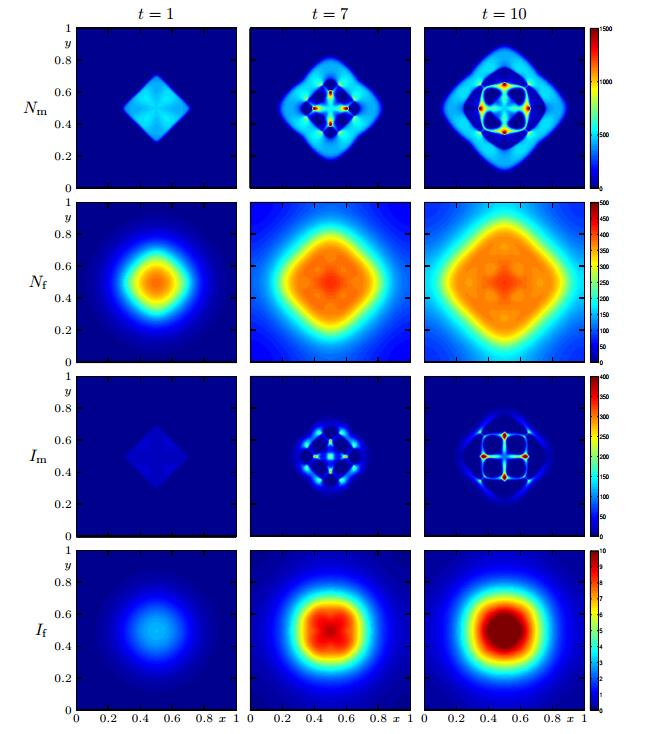
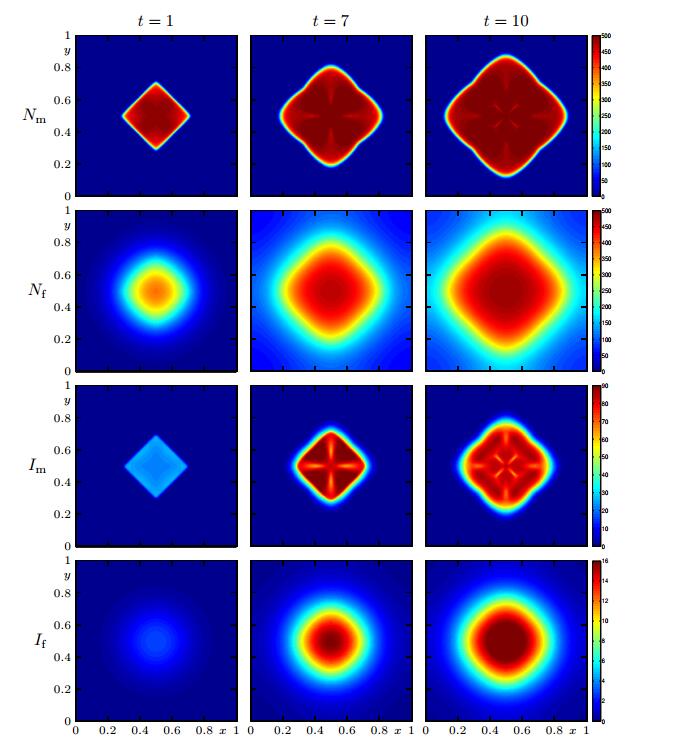
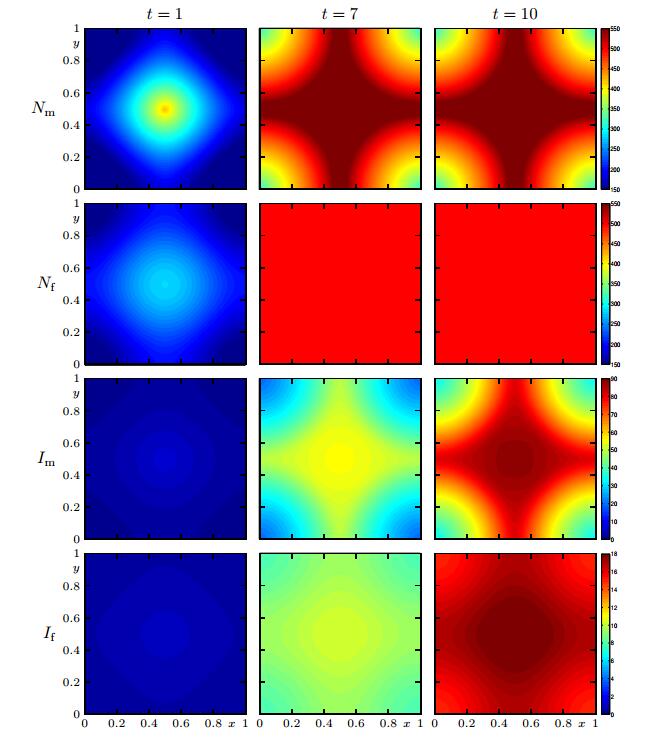

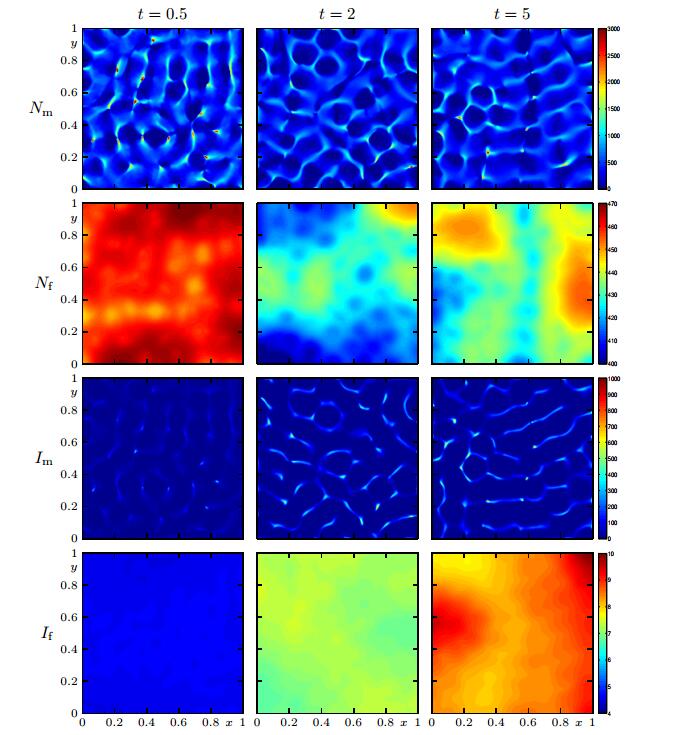
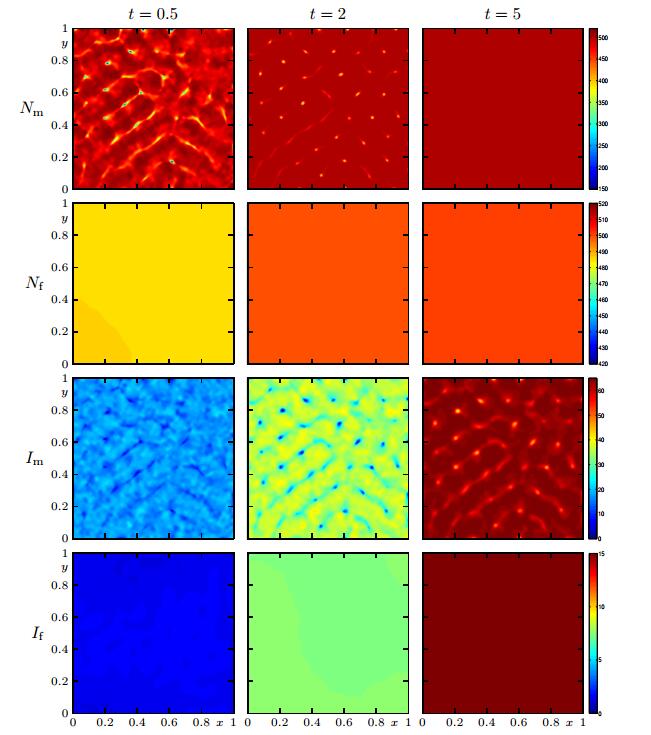
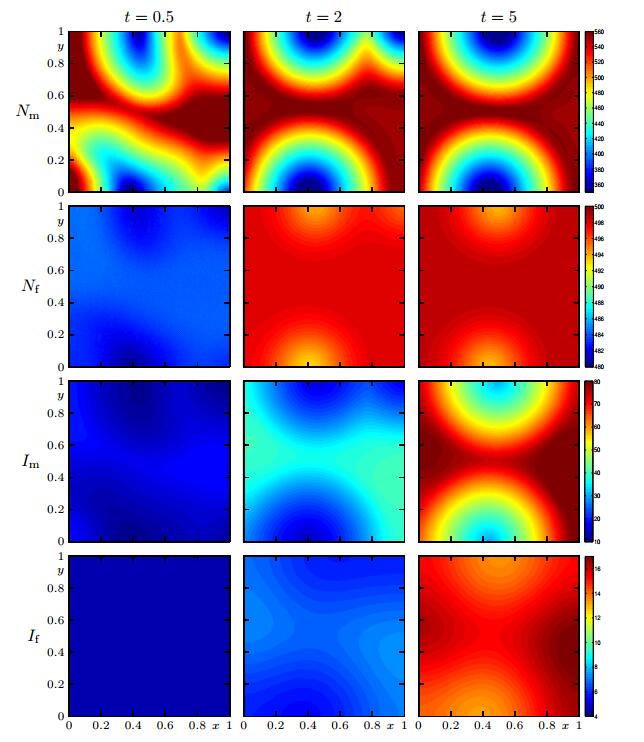
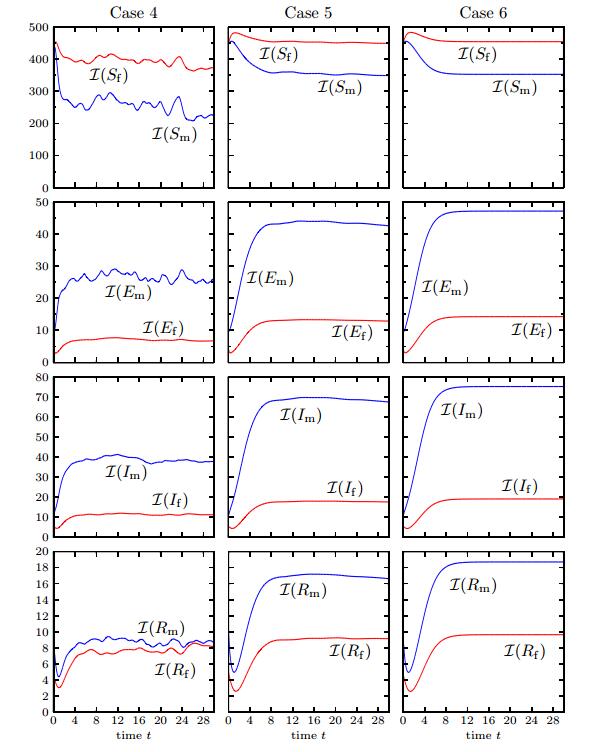
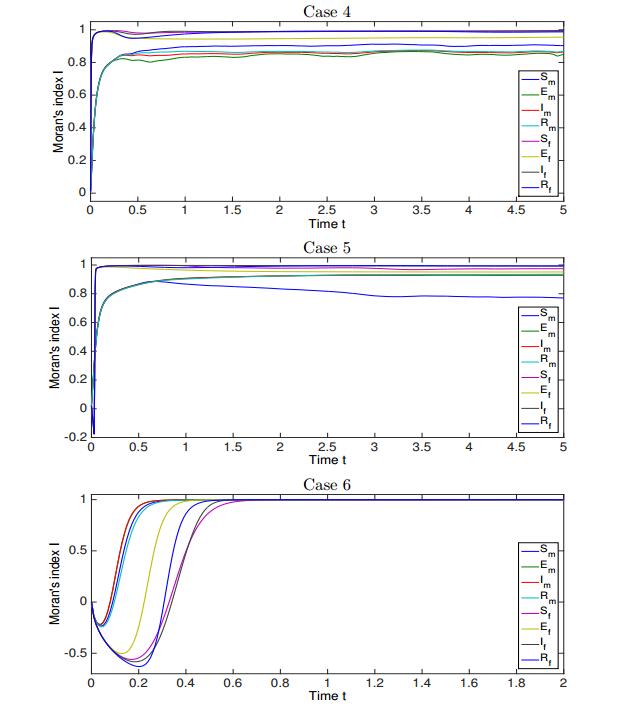
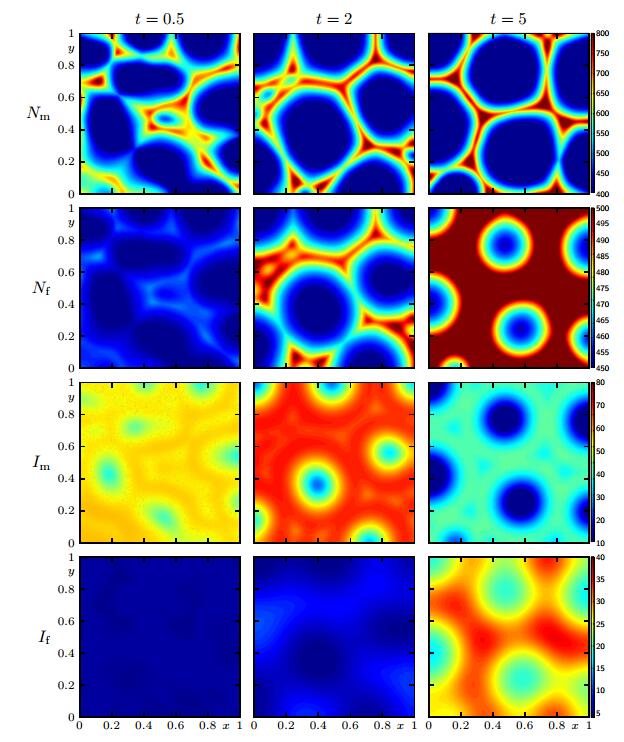



 DownLoad:
DownLoad: